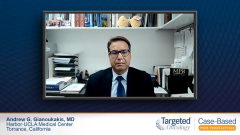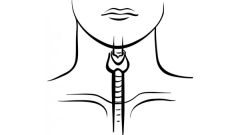
Real-World Insight: Lenvatinib for RAI-Refractory DTC
Episodes in this series

Andrew G. Gianoukakis, MD: Clinical trials are limited, and physicians [within clinical trials] do not have the flexibility they would have in clinical practice. In the clinical trials, once a dose decrease has occurred, you cannot go back up on the dose. This is something that can be done in clinical practice. If somebody has an [adverse] effect and the dose is decreased, once the [adverse] effect resolves, often an attempt can be made to go back up on the drug’s dose. Furthermore, if overall disease is controlled in a patient and there is a single lesion that appears to be progressing, in a clinical trial that patient can be deemed to have failed the medication based on RECIST progression criteria and taken off the drug. Whereas in clinical practice, that individual’s single lesion can be surgically removed or treated with external beam radiation, and the patient can continue to receive the benefits of lenvatinib for the rest of their disease. This also holds true for sorafenib when it’s used. Therefore, the duration of therapy in clinical practice for these agents can be much longer than reported in the clinical trials, which were restrictive. Personally, I’ve had patients on lenvatinib for over 8 and 9 years with either stable disease or partial remission.
Toxicities commonly seen in the SELECT trial included hypertension, proteinuria, diarrhea, and fatigue. Those were the major [adverse] effects. Also hand-foot syndrome. These [adverse] effects can surprisingly appear, resolve, then reappear. They are commonly treated with a combination of symptomatic therapy and dose reductions, as needed. It’s preferable to avoid dose reductions, if possible. We can also institute short dosing holidays. There is a paper published that shows shorter duration of dosing holidays is preferable to longer duration of dosing holidays with regard to drug efficacy. The combination of symptomatic treatment of [adverse] effects, treatment of individual progressive lesions with surgery or radiation when appropriate, and dosing holidays or dose reductions, can allow patients to remain on these medications and receive the benefits for much longer than the 18-month progression-free survival noted in the SELECT trial.
Considering age, the patient we discussed was over 70 years old. In the SELECT trial, patients over 65 and less than 65 years of age received equal benefit compared to placebo. In addition, a follow-up post hoc study focused on age did show that patients over 65 years of age had an overall survival benefit compared to placebo. However, the older patients did seem to require dose reductions and had a greater likelihood of [adverse] effects compared to the younger patients. This is something that we need to consider when treating older patients. Maybe we need to start with a lower dose of the drug and increase it, if possible, as well as be mindful of the [adverse] effects, which are more likely to occur in the older population. However, we are comforted by knowing the [adverse] effects are worth the benefit in progression-free survival, and possibly in overall survival, seen in older patients compared to the placebo.
Transcript edited for clarity.
Case: A 73-Year-Old Woman With Differentiated Thyroid Cancer
Initial Presentation
- A 73-year-old woman complains of a “lump” on her neck, with occasional swelling and dysphagia
- PMH: obese; BMI 32
- PE: palpable, nontender neck mass
Clinical Work-up and Initial Treatment
- Labs: TSH 1.1 µU/mL; all others WNL
- Ultrasound of the neck revealed a 3.0 cm mass in the right lobe of the thyroid; several suspicious lymph nodes ranging from 0.2-3.0 cm in size
- Ultrasound-guided FNAB: confirmed papillary thyroid carcinoma
- Patient underwent total thyroidectomy with bilateral central neck dissection
- Pathology: 3.0 cm papillary thyroid cancer arising in right lobe of the thyroid, 2 of 5 positive central compartment lymph nodes, largest 1.4 cm, positive extra nodal extension
- StageT2N1MX; ECOG PS 0
Subsequent Treatment and Follow-up
- She was treated with radioactive iodine
- Levothyroxine to suppression was added to treatment regimen
- Follow-up at 6 months TSH 0.4 µU/mL, thyroglobulin 4 ng/mL
- Neck US unremarkable
- Follow-up 12 months TSH 0.3 µU/mL, thyroglobulin 18 ng/mL
- US of the neck was unremarkable
- CT of the chest showed 10 lung nodules, largest 1.2 cm in size
- Administered radioactive iodine 150 millicuries
- Post therapy scan showed no lung or other uptake
- Follow-up at 2 years TSH 0.3 µU/mL, thyroglobulin 30 ng/mL
- Chest CT increasing number and size of lung nodules; largest 1.6 cm
- Patient was asymptomatic and deemed radioactive iodine refractory
- Systemic therapy with lenvatinib 24 mg PO qDay considered










































